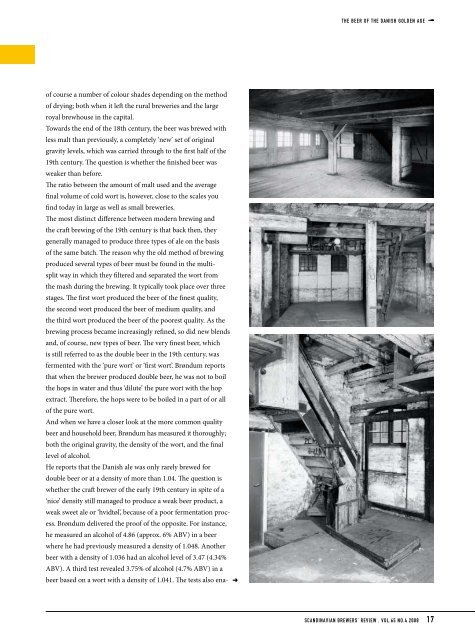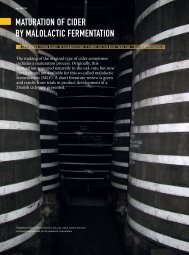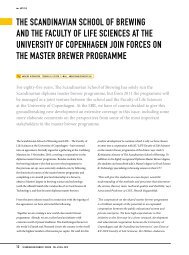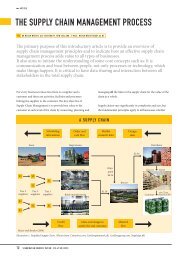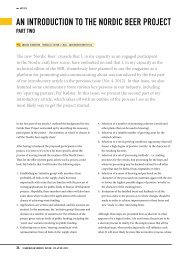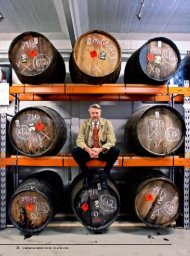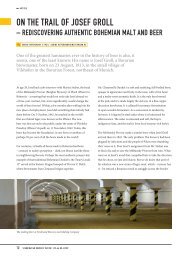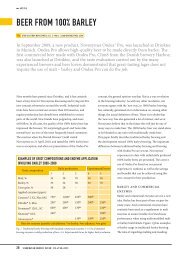The beer of The Danish GolDen aGe - Scandbrewrev.dk
The beer of The Danish GolDen aGe - Scandbrewrev.dk
The beer of The Danish GolDen aGe - Scandbrewrev.dk
You also want an ePaper? Increase the reach of your titles
YUMPU automatically turns print PDFs into web optimized ePapers that Google loves.
<strong>of</strong> course a number <strong>of</strong> colour shades depending on the method<br />
<strong>of</strong> drying; both when it left the rural breweries and the large<br />
royal brewhouse in the capital.<br />
Towards the end <strong>of</strong> the 18th century, the <strong>beer</strong> was brewed with<br />
less malt than previously, a completely ‘new’ set <strong>of</strong> original<br />
gravity levels, which was carried through to the first half <strong>of</strong> the<br />
19th century. <strong>The</strong> question is whether the finished <strong>beer</strong> was<br />
weaker than before.<br />
<strong>The</strong> ratio between the amount <strong>of</strong> malt used and the average<br />
final volume <strong>of</strong> cold wort is, however, close to the scales you<br />
find today in large as well as small breweries.<br />
<strong>The</strong> most distinct difference between modern brewing and<br />
the craft brewing <strong>of</strong> the 19th century is that back then, they<br />
generally managed to produce three types <strong>of</strong> ale on the basis<br />
<strong>of</strong> the same batch. <strong>The</strong> reason why the old method <strong>of</strong> brewing<br />
produced several types <strong>of</strong> <strong>beer</strong> must be found in the multi-<br />
split way in which they filtered and separated the wort from<br />
the mash during the brewing. It typically took place over three<br />
stages. <strong>The</strong> first wort produced the <strong>beer</strong> <strong>of</strong> the finest quality,<br />
the second wort produced the <strong>beer</strong> <strong>of</strong> medium quality, and<br />
the third wort produced the <strong>beer</strong> <strong>of</strong> the poorest quality. As the<br />
brewing process became increasingly refined, so did new blends<br />
and, <strong>of</strong> course, new types <strong>of</strong> <strong>beer</strong>. <strong>The</strong> very finest <strong>beer</strong>, which<br />
is still referred to as the double <strong>beer</strong> in the 19th century, was<br />
fermented with the ‘pure wort’ or ‘first wort’. Brøndum reports<br />
that when the brewer produced double <strong>beer</strong>, he was not to boil<br />
the hops in water and thus ‘dilute’ the pure wort with the hop<br />
extract. <strong>The</strong>refore, the hops were to be boiled in a part <strong>of</strong> or all<br />
<strong>of</strong> the pure wort.<br />
And when we have a closer look at the more common quality<br />
<strong>beer</strong> and household <strong>beer</strong>, Brøndum has measured it thoroughly;<br />
both the original gravity, the density <strong>of</strong> the wort, and the final<br />
level <strong>of</strong> alcohol.<br />
He reports that the <strong>Danish</strong> ale was only rarely brewed for<br />
double <strong>beer</strong> or at a density <strong>of</strong> more than 1.04. <strong>The</strong> question is<br />
whether the craft brewer <strong>of</strong> the early 19th century in spite <strong>of</strong> a<br />
‘nice’ density still managed to produce a weak <strong>beer</strong> product, a<br />
weak sweet ale or ‘hvidtøl’, because <strong>of</strong> a poor fermentation proc-<br />
ess. Brøndum delivered the pro<strong>of</strong> <strong>of</strong> the opposite. For instance,<br />
he measured an alcohol <strong>of</strong> 4.86 (approx. 6% ABV) in a <strong>beer</strong><br />
where he had previously measured a density <strong>of</strong> 1.048. Another<br />
<strong>beer</strong> with a density <strong>of</strong> 1.036 had an alcohol level <strong>of</strong> 3.47 (4.34%<br />
ABV). A third test revealed 3.75% <strong>of</strong> alcohol (4.7% ABV) in a<br />
<strong>beer</strong> based on a wort with a density <strong>of</strong> 1.041. <strong>The</strong> tests also ena-<br />
<strong>The</strong> <strong>beer</strong> <strong>of</strong> <strong>The</strong> <strong>Danish</strong> <strong>GolDen</strong> <strong>aGe</strong><br />
scanDinaVian brewers’ reView . Vol.65 no.4 2008 17


